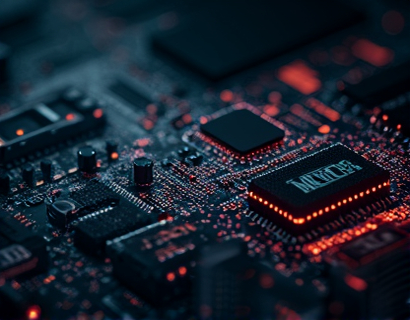Next-Gen Smart Contract AMMs: Revolutionizing DeFi Trading with Advanced Automation and Liquidity Management
The decentralized finance (DeFi) ecosystem has witnessed unprecedented growth and innovation, with smart contract-based Automated Market Makers (AMMs) emerging as a cornerstone of this transformation. These AMMs leverage advanced automation and liquidity management to redefine the trading experience, offering crypto traders and DeFi enthusiasts unparalleled efficiency and seamless market interactions. This article delves into the cutting-edge technology behind next-generation smart contract AMMs, exploring how they optimize liquidity management and automate trading strategies to ensure optimal performance in the dynamic crypto landscape.
Understanding Smart Contract AMMs
Traditional AMMs rely on algorithms to determine asset prices and manage liquidity pools, eliminating the need for order books and human intervention. Smart contract AMMs take this a step further by deploying on blockchain networks, ensuring transparency, security, and immutability. These contracts execute predefined rules automatically, facilitating trades without intermediaries. The use of smart contracts in AMMs not only reduces costs but also enhances trust among participants, as all transactions are verifiable and tamper-proof.
The core mechanism of a smart contract AMM involves liquidity pools, where users deposit assets to create a pool. These pools are used for trading, and participants earn liquidity provision rewards. The price of assets in the pool is determined by the ratio of the two assets in the pool, typically using a constant product formula such as x * y = k, where x and y are the amounts of the two assets, and k is a constant. This formula ensures that the price remains stable and predictable, reducing the slippage often associated with traditional order books.
Advanced Automation in AMMs
One of the most significant advantages of next-gen smart contract AMMs is their advanced automation capabilities. These platforms employ sophisticated algorithms to optimize trading strategies, automatically adjusting positions based on market conditions. For instance, arbitrage opportunities can be identified and exploited in real-time, ensuring that traders maximize their returns while minimizing risks. This level of automation not only enhances efficiency but also democratizes access to sophisticated trading strategies, previously available only to institutional traders.
Moreover, these AMMs integrate machine learning models to predict market trends and adjust liquidity allocations accordingly. By analyzing historical data and real-time market signals, these models can forecast price movements and optimize liquidity provision. This proactive approach to liquidity management ensures that the AMM remains resilient to market volatility, maintaining deep liquidity even during turbulent periods.
Liquidity Management Innovations
Effective liquidity management is crucial for the success of any AMM. Next-gen smart contract AMMs introduce several innovative features to enhance liquidity provision and utilization. One such feature is dynamic fee adjustment, where the trading fee is adjusted based on the liquidity depth and market conditions. During periods of high volatility or low liquidity, fees can be increased to incentivize liquidity provision, ensuring that the pool remains well-funded. Conversely, during stable periods, fees can be reduced to attract more traders and improve market efficiency.
Another key innovation is the implementation of liquidity incentives tailored to different user behaviors. For example, long-term liquidity providers can be rewarded with higher interest rates or exclusive tokens, encouraging sustained participation. Additionally, gamification elements such as leaderboards and challenges can be introduced to make liquidity provision more engaging and rewarding. These incentives not only boost liquidity but also foster a community-driven approach to DeFi, enhancing user engagement and loyalty.
Enhanced User Experience
The user experience is a critical aspect of any DeFi platform, and next-gen smart contract AMMs prioritize this through intuitive interfaces and robust functionality. These platforms offer user-friendly dashboards that provide real-time insights into liquidity positions, trading history, and portfolio performance. Advanced charting tools and customizable alerts help traders make informed decisions and stay ahead of market movements.
Security is another paramount concern, and these AMMs employ multi-signature wallets, audit-traced smart contracts, and decentralized governance to ensure the highest level of security. Users can verify transactions and contract executions through blockchain explorers, adding an extra layer of transparency. Furthermore, the use of zero-knowledge proofs and other privacy-enhancing technologies ensures that sensitive information remains confidential.
Interoperability and Cross-Chain Capabilities
As the DeFi ecosystem continues to evolve, interoperability between different blockchain networks becomes increasingly important. Next-gen smart contract AMMs are designed to be interoperable, allowing assets to be seamlessly transferred across various chains. This cross-chain functionality not only expands the liquidity pool but also enables traders to access a broader range of assets and markets. By leveraging protocols like Polkadot and Cosmos, these AMMs can facilitate atomic swaps and ensure smooth asset movement, breaking down silos and enhancing the overall DeFi experience.
Moreover, these AMMs support multiple tokens and assets, including ERC-20, BEP-20, and other custom tokens. This versatility ensures that users can trade a wide array of assets within a single platform, reducing the need to switch between different AMMs or exchanges. The support for stablecoins, cryptocurrencies, and even NFTs further broadens the applicability of these AMMs, making them a one-stop-shop for DeFi trading.
Scalability and Performance
Scalability is a significant challenge in the DeFi space, and next-gen smart contract AMMs address this through innovative layer 2 solutions and optimized smart contract design. By utilizing rollups, sidechains, and other scaling protocols, these AMMs can handle a higher volume of transactions without compromising on speed or security. This ensures that the platform remains responsive and efficient, even during peak usage times.
Optimized smart contract design is another critical factor. These contracts are coded to minimize gas costs and execution time, making them cost-effective and fast. The use of efficient data structures and optimized algorithms ensures that transactions are processed quickly, reducing the overall cost for users. This performance optimization is essential for maintaining user satisfaction and encouraging widespread adoption.
Decentralized Governance and Community Involvement
Decentralized governance is a cornerstone of the next-generation AMMs, empowering the community to have a say in the platform's development and decision-making processes. Through decentralized autonomous organizations (DAOs), token holders can propose and vote on upgrades, feature additions, and other critical changes. This governance model not only ensures that the platform evolves in line with user needs but also fosters a sense of ownership and community among participants.
Community involvement extends beyond governance to include active participation in liquidity provision, testing, and feedback. Users can contribute to the platform's growth by providing liquidity, testing new features, and offering valuable insights through community forums. This collaborative approach not only enhances the platform's robustness but also builds a strong, engaged user base.
Conclusion
The integration of advanced automation and liquidity management in next-gen smart contract AMMs represents a significant leap forward in DeFi trading. These platforms offer a seamless, efficient, and secure trading experience, leveraging cutting-edge technology to optimize liquidity and automate trading strategies. As the DeFi ecosystem continues to mature, these AMMs will play a pivotal role in shaping the future of decentralized finance, providing users with unparalleled tools and opportunities to thrive in the dynamic crypto landscape.











































